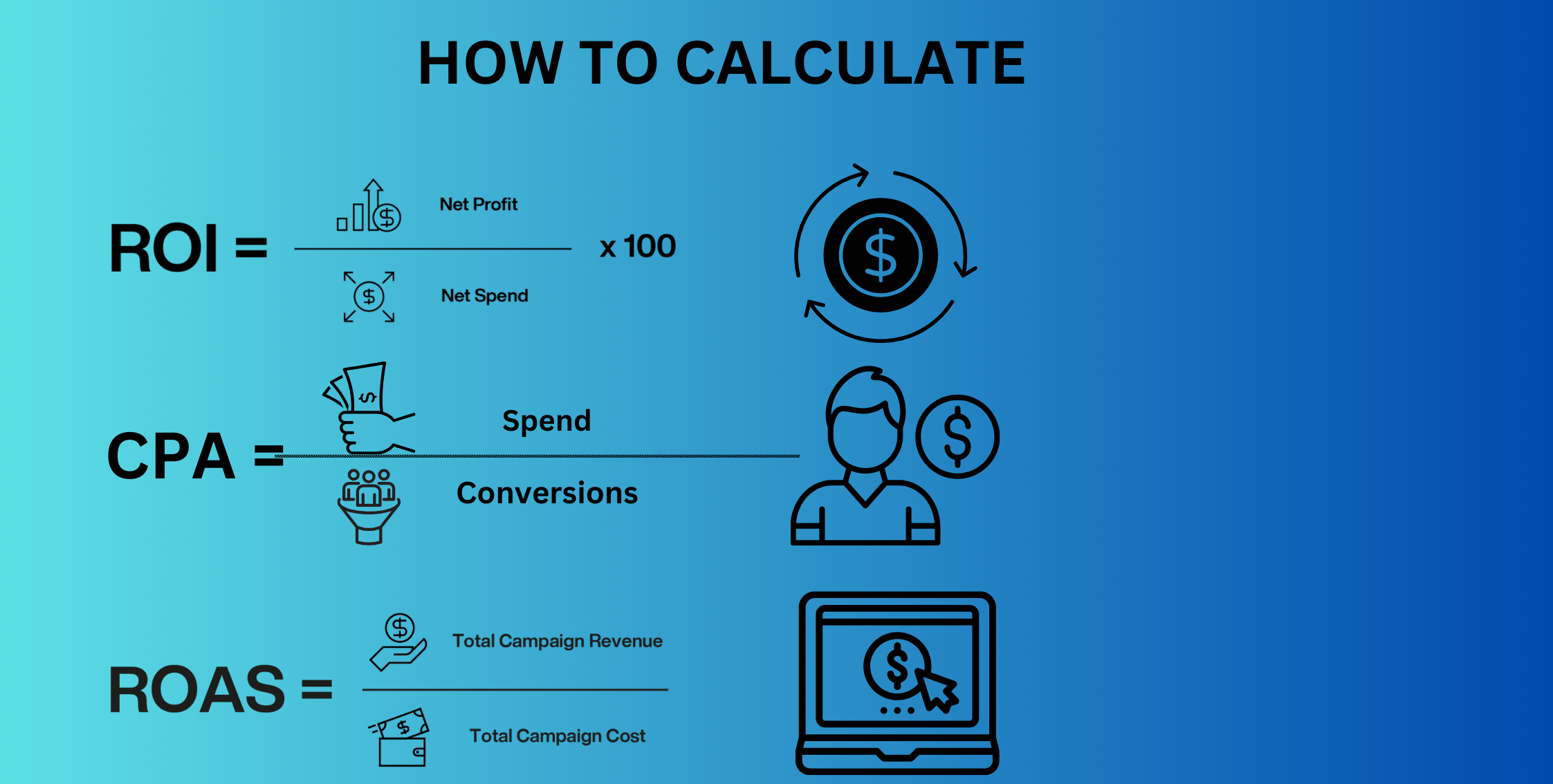In the ever evolving landscape of digital marketing, measuring the success of your campaigns is paramount. To effectively gauge your advertising efforts, you need to rely on key performance indicators (KPIs) that provide valuable insights into your Return on investment (ROI) and overall campaign performance.
Three crucial metrics that every marketer should be well -versed in are Cost Per Acquisition (CPA), Return on Ad Spend (ROAS), and Return on Investment (ROI).
Cost Per Acquisition (CPA)
What is CPA?
Cost Per Acquisition (CPA) is a metric that measures how much it costs you to acquire a single customer or lead through your advertising efforts. It’s a fundamental metric that helps you understand the Efficiency of your ad spend in terms of generating conversions, such as sales, sign ups, downloads or any other desired action.
How to Calculate CPA
To Calculate CPA we use the following formula
|
CPA= Total Advertising Costs/ Number of conversions |
Here’s a breakdown of the components
- Total Advertising Costs: this is the total amount of money spent on your advertising campaign. It includes expenses related to various advertising channels, such as pay per click (PPC) advertising, social media advertising, display advertising or any other forms of digital marketing.
- Number of conversions: conversions represent the desired actions taken by users as a result of your advertising efforts. These actions are specific to your campaign goals and could be anything from making a purchase to filling out a contact form or subscribing to a newsletter.
|
Remember CPA can vary by industry and campaign objectives, so set benchmarks for comparison. |
Example
Imagine you are the marketing manager for an e-commerce company and you run an online advertising campaign on a social media platform . You spent $2000 on advertising and you tracked the following conversions:
- 100 people clicked on your ad and completed a purchase on your website.
- 50 people clicked on your ad but didn’t make a purchase.
Now let’s calculate the CPA for this campaign:
Step 1: Determine Total Advertising costs
The total advertising costs for this campaign are the amount you spent on Google Ads which is $2000.
Step 2: count the number of Conversions
In this case , conversions represent customers who completed a purchase on your website. You had 100 conversions during the campaign.
Step 3: Calculate CPA
Use the formula for CPA
CPA= total advertising costs/ number of conversions
CPA= $2000(total Advertising costs)/ 100(Number of Conversions)= $20 per acquisition.
So, in this example, your Cost per Acquisition for the Google Ad campaign is $20 per customer acquisition. This means it costs you $20 in advertising expenses to acquire each customer who made a purchase as a result of clicking on your ad.
Return On Ad Spend (ROAS)
What is ROAS?
Return on Ad Spend (ROAS) is a metric that evaluates the effectiveness of your advertising campaigns by measuring the revenue generated for every dollar spent on advertising. In essence, It helps you understand how efficiently your ad dollars are turning into revenue.
How to Calculate ROAS
The formula to calculate ROAS is
ROAS= (Revenue from Advertising/ Total Advertising Costs) |
ROAS is often expressed as a ratio or percentage. In some cases, you may multiply the result by 100 to represent ROAS as a percentage.
Here’s a breakdown of the components:
- Revenues from advertising: this is the total revenue generated from your advertising campaigns. It includes all sales, conversions or other revenue-generating actions attic to your advertising efforts.
- Total Advertising costs: these are the expenses incurred while running your advertising campaigns. It includes costs associated with ad placements, creative development and any fees paid to advertising platforms.
Example
Suppose you run an e-commerce store and you invested $1,000 in a Google Ads campaign to promote a new line of smartphones. As a result of this campaign, you generated $5,000 revenue from sales of these smartphones.
Now let’s calculate the ROAS
ROAS= ($5000(Revenue from advertising)/ $1000 (Total Advertising Costs)) =5
You can represent this as a percentage by multiplying it by 100
ROAS= 5*100= 500%
In this example, your ROAS is 500%. This means that for every dollar you spent on advertising, you generated $5 in revenue. A ROAS above 100% indicates that your advertising campaign is generating more revenue than it costs, which is typically considered a positive outcome.
ROAS is a valuable metric for advertisers as it helps in assessing the profitability and efficiency of their advertising spend. It allows marketers to allocate their budget more effectively by identifying which campaigns or advertising channels provide the best return on their investment.
If you have any queries about our analytics services, get in touch with us to let our team of highly professional experts take care of your concerns.
Return On Investment (ROI)
What is ROI?
Return on Investment (ROI) is a broader metric that evaluates the overall return on your investment in marketing, encompassing all costs associated with your marketing efforts, including advertising expenses , labor costs, and overhead.
How to calculate ROI
The formula to Calculate ROI is:
|
ROI= (Net Profit/ Cost of Investment) * 100 |
Here’s a breakdown of the components
- Net Profit: this represents the total profit earned from the investment. It takes into account the revenue generated by the investment and subtracts all associated costs and expenses.
- Cost of Investment: This is the initial amount of money invested in a project, asset , or initiative. It includes all direct and indirect costs associated with the investment.
|
TIP Track all Expenses:Consider both direct and indirect costs when calculating ROI to get a comprehensive view of your investment. |
(Related Article: https://www.analyticodigital.com/blog/google-adwords-marketers-guide-to-improving-roi )
Example
Suppose you decide to invest $10000 in a stock, and after one year, your investment has grown to $12,000. During the year you also incurred $500 in trading fees and $200 in researxh expenses related to managing your investment.
Now let’s calculate the ROI:
ROI= (($12,000(Final Value)- $10,000(Initial Investment) - $500(Trading Fees) - $200 (Research Expenses))/$10,000(Initial Investment)) *100
ROI= ($1300//$10,000)*100
ROI=13%
In this example , your ROI is 13%. This means that for every dollar you invested, you earned a return of 13 cents.
ROI is a versatile metric and can be applied to various types of investments, including financial investments like stocks and bonds, marketing campaigns, real estate purchases, business projects, and more. It helps individuals and businesses make informed decisions about where to allocate their resources and assess the performance of their investments in achieving their financial goals.
Interpreting the Metrics
Understanding these metrics is essential, but interpreting them is equally important.
- CPA
A low CPA indicates efficient advertising spend and cost-effective customer acquisition. If your CPA is too high, you might need to refine your targeting or creative strategies.
- ROAS
A ROAS above 100% indicates that your advertising is generating more revenue than your spending. It’s often used in e-commerce to assess the performance of specific ad campaigns or channels.
- ROI
ROI provides a holistic view of the profitability of your marketing efforts. A positive ROI means your marketing investments are generating more revenue than they cost. A negative ROI indicates that your marketing efforts are not generating enough revenue to justify the expenses.
Conclusion
Mastering CPA, ROAS, and ROI is important for assessing the effectiveness of your digital marketing campaigns. These metrics empower you to make informed decisions, allocate budgets wisely and optimize your marketing efforts for maximum profitability.
Regularly monitoring and interpreting these metrics will help you stay ahead in the dynamic world of digital marketing.
Found this helpful? Check out more interesting articles from our blog.


